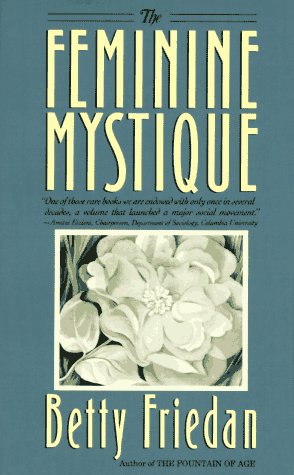The Feminine Mystique Summary
8 min read ⌚
 You scoff at the person claiming that you have been destined to be a housewife as you are booking your next flight to an all-girls holiday in the Bahamas?
You scoff at the person claiming that you have been destined to be a housewife as you are booking your next flight to an all-girls holiday in the Bahamas?
Well, in case you didn’t know, you have Betty Friedan to thank.
And her 1963 seminal book, “The Feminine Mystique”!
Who Should Read “The Feminine Mystique”? And Why?
Inspired by her 1957 survey of former college friends, Betty Friedan’s “The Feminine Mystique” is one of the books – if not the book – which created the feminist movement.
It is based on the simple premise that many women are unhappy with their roles as mothers and housewives.
And that, if there are such things as human free will and human choice, they should be able to live their lives differently.
Feeling somewhat similar?
Then “The Feminine Mystique” is where you should start searching for solutions.
Don’t look away, men – you should read this book even sooner than women.
It talks about your unhappy wives.
About Betty Friedan
Betty Friedan was an American feminist writer and life-long activist, a leading figure in the women’s movement in the United States during the second half of the 20th century.
was an American feminist writer and life-long activist, a leading figure in the women’s movement in the United States during the second half of the 20th century.
She was propelled to this role in 1963 when her book “The Feminine Mystique” first identified “The Problem That Has No Name” for so many women in the world. Three years later, she became the first president of NOW, the National Organization for Women.
In 1970, she organized a nationwide Women’s Strike for Equality, the largest of its kind up to that moment.
She remained politically active until her death, authoring six books and participating in many debates on controversial women’s rights topics.
“The Feminine Mystique PDF Summary”
In 1957, at their 15th-anniversary reunion, Friedan conducted a survey of her former Smith College classmates.
Back when they studied together, most of them were smart, ambitious, capable, dreamy-eyed. But, in 1957, almost all of them were unhappy, unfulfilled, empty.
Simply put, they struggled with the fact that what they were expected to be was nothing more than housewives and mothers.
And since nobody taught them before that they may be some other way, each suburban wife struggled with this “problem that has no name” alone:
As she made the beds, shopped for groceries, matched slipcover material, ate peanut butter sandwiches with her children, chauffeured Cub Scouts, and Brownies, lay beside her husband at night – she was afraid to ask even of herself the silent question – ‘Is this all?
And Friedan goes on to answer that – no, it isn’t.
Or, at least, it shouldn’t be.
In Chapter 1, “The Problem That Has No Name,” she turns her attention to the fact that women are getting less and less happy with every passing year.
In her opinion, the reason behind this is simple: they marry earlier, and they have more children.
And they have no idea what to do after.
“We can no longer ignore that voice within women that says: ‘I want something more than my husband and my children and my home.'”
Now that is the actual name of the problem.
Chapter 2, “The Happy Housewife Heroine,” shows how even in the 1960s we weren’t that far off from Mary Wollstonecraft’s 18th century.
Sure, education was better and more democratic, but women’s magazines – almost exclusively owned and edited by men – still portrayed women either as happy housewives or unhappy careerwomen.
Pretty unbiased, won’t you say?
If you have problems guessing the choice most women made in the 1960s, Betty Friedan explains how most women would think by describing her personal journey in Chapter 3, “The Crisis in Woman’s Identity.”
She didn’t have time to think about education and work.
As her biological clock started ticking like this, and she watched her friends getting married and giving birth to their children, she started believing that if she doesn’t do the same as soon as possible, she would never fulfill her anatomical destiny.
And that she would be a failure.
Chapter 4, “The Passionate Journey,” is a magnifying glass: Friedan moves from her personal to the journey of the whole feminist movement, from suffrage to the 1950s.
In Chapter 5, “The Sexual Solipsism of Sigmund Freud,” Friedan picks up a fight with none other but the father of psychology.
How could she not?
This is what Freud had written once:
I believe that all reforming action in law and education would break down in front of the fact that, long before the age at which a man can earn a position in society, Nature has determined woman’s destiny through beauty, charm, and sweetness. Law and custom have much to give women that has been withheld from them, but the position of women will surely be what it is: in youth an adored darling and in mature years a loved wife.
Highlights: women’s destiny has been biologically determined, and they can be either adored darlings or loved wives.
Nice going, Freud!
Friedan’s point:
None of it is proven. Especially not the concept of “penis envy” (and women’s neurosis which stems from it) which people (read: men) in her days threw around as if it as certain as gravity.
Time has had Friedan’s back: most of Freud’s theories have been proven to be just a bunch of baloney!
Chapter 6, complexly titled “The Functional Freeze, the Feminine Protest, and Margaret Meade,” challenges the idea of structural functionalists who believed that society functions because all participants have functional roles within it.
You get zero points for guessing whose functional shoes women were supposed to fill in!
Chapter 7, “The Sex-Directed Educators,” extends the discussion on functionalism and its effect on education which was designed to create a specific role for women: that of a housekeeper.
Congratulations, Mary Wollstonecraft: you were two centuries ahead of your time!
Chapter 8, “The Mistaken Choice,” examines how World War II and the Cold War have resulted in a world as prehistoric as prehistory itself! Even though women had to – and did – take men’s jobs during the war, they were still looked at as housewives, since only men were capable of fighting.
And ads made sure that women’s place is their homes and kitchens.
Speaking of which –
That’s exactly what Chapter 9, “The Sexual Self,” goes on about. The advertising industry, in the eyes of Friedan, has invented a career out of housekeeping and created a multi-billion industry in order to sell women millions of unnecessary products!
Chapter 10, “Housewifery Expands to Fill the Time Available,” is based on few interviews with housewives.
Its findings?
Devastating!
Women are not only unfulfilled housewives but also housewives who purposefully invent housekeeping tasks even when they are none, so as not to feel left behind.
Because – what else are they going to do?
In the controversial Chapter 11, “The Sex-Seekers,” Friedan gives a provocative answer: sex. Because, basically, it is the only fun thing they can do besides caring for their children and their husbands.
However, sex is also unfulfilling, and it often leads to infidelity and marriage problems.
Chapter 12, “Progressive Dehumanization: The Comfortable Concentration Camp,” examines the most troubling effect of this type of unfulfillment: emotionally immature children.
Namely, unfulfilled mothers try to live their lives through their children, causing them to lose the sense of individuality and grow up into underdeveloped adults.
Chapter 13, “The Forfeited Self,” sets this proto-sex-vs-gender discussion against Abraham Maslow’s hierarchy of needs, concluding that, unlike men, who have the opportunity to reach self-actualization, women are purposefully trapped at the lowest and basest physiological stage of their existence.
Finally, Chapter 14, “A New Life Plan for Women,” presents several case studies of women who managed to outgrow their feminine mystiques and become successful self-actualized careerwoman much instead of being enslaved as merely mothers and housewives.
Key Lessons from “The Feminine Mystique”
1. The Feminine Mystique: The Problem That Has No Name
2. Happy Housewives and Unhappy Careerwomen
3. Beyond Physiology: The Self-Actualized Woman
The Feminine Mystique: The Problem That Has No Name
Betty Friedan – just like millions of American women in her days – suffered from a serious case of “knowing-not-what-life-is-all-about.”
She was taught that her objective is to get married, have children, and raise them into perfect adults.
Now that she was in the position to do that, she realized that it’s not as fulfilling as people told her it’d be.
And while doing a survey of her former classmates, she had a revelation: it never was.
Women were lied to for centuries so that they can become what men wanted them to become. And they were manipulated for so long that now even they don’t know that life can be more than being a mother and a housewife.
“We can no longer,” writes Friedan, “ignore that voice within women that says: ‘I want something more than my husband and my children and my home.'”
And, indeed, we can’t.
Happy Housewives and Unhappy Careerwomen
During the 1950s, most editorial boards of famous magazines were men-only. And almost all of them depicted women either as happy housewives or unhappy careerwomen.
Psychologists such as Sigmund Freud and even controversial anthropologists such as Margaret Meade went no step further, infantilizing women and defining them mostly relationally.
It’s all just a big lie, said Friedan.
No science backs any of these claims.
Moreover, women’s unhappiness should be enough in itself to refute them.
Beyond Physiology: The Self-Actualized Woman
Betty Friedan applies Abraham Maslow’s hierarchy of needs to both sexes and comes to upsetting results.
Namely, while men are allowed to reach self-actualization, women’s role in society is defined solely on a physiological level.
In other words – if they can give birth and lactate, they should be mothers and nothing more.
But, as Hume has shown us, there’s a big difference between what is and what ought to be.
And Betty Friedan says: women ought to be happy self-actualized humans.
Do you have anything against it?
Like this summary? We’d like to invite you to download our free 12 min app, for more amazing summaries and audiobooks.
“The Feminine Mystique Quotes”
The only way for a woman, as for a man, to find herself, to know herself as a person, is by creative work of her own. Share on X The choice to have a child makes the whole experience of motherhood different, and the choice to be generative in other ways can at last be made, and is being made by many women now, without guilt. Share on X It is perhaps beside the point to remark that bowling alleys and supermarkets have nursery facilities, while schools and colleges and scientific laboratories and government offices do not. Share on X The feminists had destroyed the old image of woman, but they could not erase the hostility, the prejudice, the discrimination that still remained. Share on X Who knows what women can be when they are finally free to become themselves? Who knows what women's intelligence will contribute when it can be nourished without denying love? Share on XOur Critical Review
“The Feminine Mystique,” almost singlehandedly, sparked second-wave feminism in the United States, inspiring many women to fight more dedicatedly for their rights, and many lawmakers to finally listen.
Consequently, it shouldn’t surprise anyone that we decided to include this book among our “Top 15 Nonfiction Books in History.”
That says a lot how we feel about it.
To quote Arianna Huffington: “If you’ve never read it, read it now.”
Emir is the Head of Marketing at 12min. In his spare time, he loves to meditate and play soccer.







